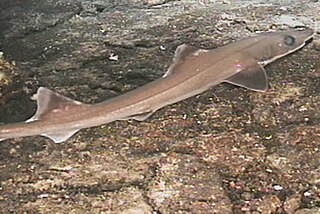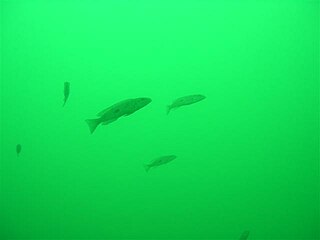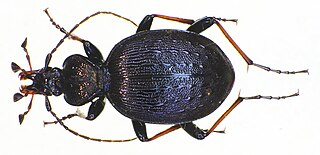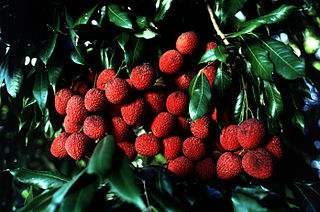
The slender glass lizard is a legless lizard in the family Anguidae. The species is endemic to the United States. Two subspecies are recognized. The lizard was originally believed to be a subspecies of Ophisaurus ventralis. Their name comes from their easily broken tail which they can break off themselves without ever being touched. It is difficult to find a specimen with an undamaged tail. The lizard eats a variety of insects and small animals, including smaller lizards. Snakes and other animals are known to prey on the species. They are vulnerable or endangered in some states due to humans destroying their environment and killing their food supply with insecticides.

The slender smooth-hound or gollumshark is a species of ground shark in the family Pseudotriakidae. It is endemic to the waters around New Zealand, where it is usually found close to the bottom over the continental slope at depths of 300–600 m (980–1,970 ft). An extremely slim, plain brownish shark reaching 1.1 m (3.6 ft) in length, the slender smooth-hound can be identified by its broad, flattened head with a long, distinctively bell-shaped snout. Its mouth is angular with short furrows at the corners, and contains a very high number of tooth rows in both jaws. Its two dorsal fins are roughly equal in size.

Gollum is a genus of ground sharks in the family Pseudotriakidae, native to the southwestern Pacific Ocean. The genus was described in 1973 by biologist Leonard Compagno, who named it named after the character Gollum from J. R. R. Tolkien's works, noting the species Gollum attenuatus "bears some resemblance in form and habits".

The California slender salamander is a lungless salamander that is found primarily in coastal mountain areas of Northern California, United States as well as in a limited part of the western foothills of the Sierra Nevada, California, in patches of the northern Central Valley of California, and in extreme southwestern Oregon. What makes this amphibian notable is that this species resides primarily in a limited range within California as one of a handful quasi-endemic amphibians in the state.

Lepidiolamprologus attenuatus is a species of cichlid endemic to Lake Tanganyika preferring areas with sandy substrates in which it digs crater-shaped nests. This species is carnivorous preying on fishes. This species can reach a length of 15 centimetres (5.9 in) TL. It can also be found in the aquarium trade.
Hobbseus is a genus of crayfish in the family Cambaridae. It comprises seven species, six of which are endemic to Mississippi; H. prominens is the only species to range outside Mississippi, being also found in Alabama. Three of the seven species are listed as endangered (EN) on the IUCN Red List, while three are of uncertain status (DD) and one is of least concern (LC).
Placodiscus is a genus of plant in family Sapindaceae. The following species are accepted by Plants of the World Online:
Placodiscus bancoensis is a species of plant in the family Sapindaceae. It is found in Ivory Coast and Ghana. It is threatened by habitat loss.
Placodiscus boya is a species of plant in the family Sapindaceae. It is found in Côte d'Ivoire and Ghana. It is threatened by habitat loss.
Placodiscus bracteosus is a species of plant in the family Sapindaceae. It is found in Ivory Coast and Ghana. It is threatened by habitat loss.
Placodiscus caudatus is a species of plant in the family Sapindaceae. It is found in Cameroon, Central African Republic, and Gabon. Its natural habitat is subtropical or tropical moist lowland forests. It is threatened by habitat loss.
Placodiscus oblongifolius is a forest tree in the family Sapindaceae. It is endemic to lowland rain forests of West Africa, with the best studied populations in Ghana.
Placodiscus opacus is a species of plant in the family Sapindaceae. It is found in Cameroon, Central African Republic, Equatorial Guinea, and Gabon. Its natural habitat is subtropical or tropical moist lowland forests. It is threatened by habitat loss.
Placodiscus paniculatus is a species of plant in the family Sapindaceae. It is endemic to the Democratic Republic of the Congo.
Placodiscus pseudostipularis is a species of plant in the family Sapindaceae. It is found in Ivory Coast, Ghana, Liberia, and Sierra Leone. It is threatened by habitat loss.

Cychrus attenuatus is a species of beetle from a Carabidae family, that is endemic to Europe. It is found in Austria, Belgium, Bosnia and Herzegovina, Croatia, the Czech Republic, mainland France, Germany, Hungary, mainland Italy, Liechtenstein, Luxembourg, Moldova, North Macedonia, Poland, Romania, Slovakia, Slovenia, Switzerland, and Ukraine.
Crinotonia attenuatus is a species of shrimp found in the Pacific and Indian Oceans. It was first named by A. J. Bruce in 1971, as Periclimenes attenuatus.

Penstemon attenuatus is a species of flowering plant in the plantain family known by the common names sulphur penstemon and taperleaf beardtongue. It is native to the northwestern United States.
Retifusus attenuatus is a species of sea snail, a marine gastropod mollusc in the family Buccinidae, the true whelks.









